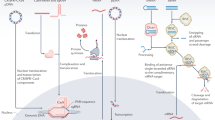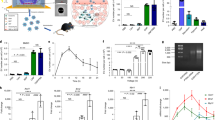Abstract
Linking proteins directly to nucleic acids has been a complex task. By hybridizing a bifunctional peptide nucleic acid (PNA) consisting of a nucleic acid binding moiety and a nuclear localization signal (NLS) we have previously demonstrated that it is possible to link protein functions directly to nucleic acids containing a PNA target site. By hybridizing fluorescently labeled oligonucleotides to PNA-NLS molecules and subsequently transfecting different organs in vivo we demonstrate an active nuclear translocation of the PNA-NLS/oligonucleotide complex in different mouse organs.
This is a preview of subscription content, access via your institution
Access options
Subscribe to this journal
Receive 12 print issues and online access
$259.00 per year
only $21.58 per issue
Buy this article
- Purchase on Springer Link
- Instant access to full article PDF
Prices may be subject to local taxes which are calculated during checkout




Similar content being viewed by others
References
Nielsen PE . Peptide nucleic acids: on the road to new gene therapeutic drugs Pharmacol Toxicol 2000 86: 3–7
Yoneda Y et al. A long synthetic peptide containing a nuclear localization signal and its flanking sequences of SV40 T-antigen directs the transport of IgM into the nucleus efficiently Exp Cell Res 1992 201: 313–320
Oswel Research Products Ltd, Lab 5005, Medical and Biological Sciences Building, University of Southampton, UK,http://www.oswel.com
Brandén LJ, Mohamed AJ, Smith CIE . A peptide nucleic acid-nuclear localization signal fusion that mediates nuclear transport of DNA Nature Biotechnol 1999 17: 784–787
Mujumdar RB et al. Cyanine dye labeling reagents: sulfoindocyanine succinimidyl esters Bioconj Chem 1993 4: 105–111
Boussif O et al. A versatile vector for gene and oligonucleotide transfer into cells in culture and in vivo: polyethylenimine Proc Natl Acad Sci USA 1995 92: 7297–7301
Kircheis R et al. Coupling of cell-binding ligands to polyethylenimine for targeted gene delivery Gene Therapy 1997 4: 409–418
Miyamoto Y et al. Differential modes of nuclear localization signal (NLS) recognition by three distinct classes of NLS receptors J Biol Chem 1997 272: 26375–26381
Köhler M et al. Cloning of two novel human importin-α subunits and analysis of the expression pattern of the importin-α protein family FEBS Lett 1997 417: 104–108
Liu F, Song YK, Liu D . Hydrodynamics-based transfection in animals by systemic administration of plasmid DNA Gene Therapy 1999 6: 1258–1266
Acknowledgements
This research has been supported by the Swedish Research Council.
Author information
Authors and Affiliations
Rights and permissions
About this article
Cite this article
Brandén, L., Christensson, B. & Smith, C. In vivo nuclear delivery of oligonucleotides via hybridizing bifunctional peptides. Gene Ther 8, 84–87 (2001). https://doi.org/10.1038/sj.gt.3301345
Received:
Accepted:
Published:
Issue Date:
DOI: https://doi.org/10.1038/sj.gt.3301345
Keywords
This article is cited by
-
Nanotechnology approaches for gene transfer
Genetica (2009)
-
Nuclear entry of nonviral vectors
Gene Therapy (2005)
-
Combination of a new generation of PNAs with a peptide-based carrier enables efficient targeting of cell cycle progression
Gene Therapy (2004)
-
The many faces of PNA
International Journal of Peptide Research and Therapeutics (2003)



